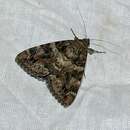Biology
provided by Arkive
The main flight period of this single-brooded species (4) occurs from late July to late August (7). The caterpillars, which feed on oak, can be found from late April to early June and the overwintering stage is the egg (8).
Conservation
provided by Arkive
The Light Crimson Underwing is a priority species under the UK Biodiversity Action Plan (UK BAP). The Species Action Plan produced aims to maintain all known populations, and enhance the numbers of the species at all sites by the year 2010 (1). Most existing populations occur in the New Forest or in Sites of Special Scientific Interest (SSSIs) in the vicinity. The New Forest has been forwarded as a candidate Special Area of Conservation, a site designation that has stemmed from the EC Habitats Directive (1). Reintroduction of the species into parts of its former range has been proposed, and research and monitoring programmes are in development (1).
Description
provided by Arkive
The generic name of the Light Crimson Underwing, Catocala derives from the Greek 'kato' meaning below and 'kalos' meaning beautiful, and refers to the brightly coloured hindwings of the underwing moths (5). This species is similar in appearance to the Dark Crimson Underwing Catocala sponsa; the hind wings of both are crimson and black in colour. The caterpillar is greenish-grey and has yellow-brown patches (6).
Habitat
provided by Arkive
Requires extensive areas of mature oak woodland (Quercus species) (1).
Range
provided by Arkive
This moth has been recorded in most European countries with the exception of Ireland, Malta and Albania. It becomes more rare towards the northern-most parts of its range, which reaches east to Siberia and south to North Africa (1). In the UK it is now restricted to areas in and around the New Forest, Hampshire (1) and in Wiltshire (2), but was historically recorded from a wider range in the south of England (1).
Status
provided by Arkive
Classified as Rare in Great Britain (1).
Threats
provided by Arkive
Many large areas of mature oak woodland have been felled, in some cases this has been replanted with species other than oak (1). This has resulted in a decrease in the area of suitable oak woodland for this moth, and increased fragmentation of remaining habitat (1).
Catocala promissa
provided by wikipedia EN
Catocala promissa, the light crimson underwing, is a moth of the family Erebidae. The species was first described by Michael Denis and Ignaz Schiffermüller in 1775.[1] It can be found in Europe and Anatolia up to Armenia.
Technical description and variation
C. promissa Esp. (= mneste Hbn.). Smaller than sponsa; forewing with the ground colour white dusted with pale and dark grey; the costal edge between the lines white; the basal line and streak from base below cell black; the inner line double, black, forming a bluntly rounded projection in submedian interval, generally accompanied by a diffuse black shade forming a band; space between outer and subterminal lines filled in with dark; subterminal line pale grey, zigzag, externally black-edged; median space generally paler grey, especially on costa before reniform and before outer line; reniform with blackish centre and pale grey ring, placed in a diffuse dark median shade, the spot below it generally pale grey distinctly outlined with black; hindwing crimson with broad black terminal border and narrow sinuous median band, not reaching inner margin; the sinuosity of the band varies much, appearing to be greatest in British and Hungarian examples; instances where the band actually reaches inner margin are very rare and confined to dark-suffused females; — ab. ochracea Oberth., from Valais and Silesia, has the hindwing pale yellow ochreous in place of red; — ab. rosea Tutt has the dorsum red like the hindwings, as recorded by Guenee; in the ab. obsoleta Schultz the black bands of the hindwing, instead of being concisely marked, as usual, are diffusely edged and run into the red ground colour, giving the whole wing a dark appearance. Larva bluish grey or greenish grey, with irregularly shaped black marks on the dorsum and sides, varying in intensity; tubercles fine, white; hump on segment 9 surrounded by black, white in middle; that on segment 12 bearing two strong points; head yellow with black marks; venter with a row of black spots; the lateral filamentary processes very strongly developed.[2] The wingspan is 60–65 mm.

Figs. 1 young larva 1a, 1b larvae after last moult 1c pupa
Biology
The moths flies from July to August depending on the location. The larvae feed on oaks.
References
-
^ Yu, Dicky Sick Ki. "Catocala promissa (Denis & Schiffermuller 1775)". Home of Ichneumonoidea. Taxapad. Archived from the original on March 15, 2016.
-
^ Warren. W. in Seitz, A. Ed., 1914 Die Großschmetterlinge der Erde, Verlag Alfred Kernen, Stuttgart Band 3: Abt. 1, Die Großschmetterlinge des palaearktischen Faunengebietes, Die palaearktischen eulenartigen Nachtfalter, 1914
 This article incorporates text from this source, which is in the public domain.
This article incorporates text from this source, which is in the public domain.

- license
- cc-by-sa-3.0
- copyright
- Wikipedia authors and editors
Catocala promissa: Brief Summary
provided by wikipedia EN
Catocala promissa, the light crimson underwing, is a moth of the family Erebidae. The species was first described by Michael Denis and Ignaz Schiffermüller in 1775. It can be found in Europe and Anatolia up to Armenia.
- license
- cc-by-sa-3.0
- copyright
- Wikipedia authors and editors

